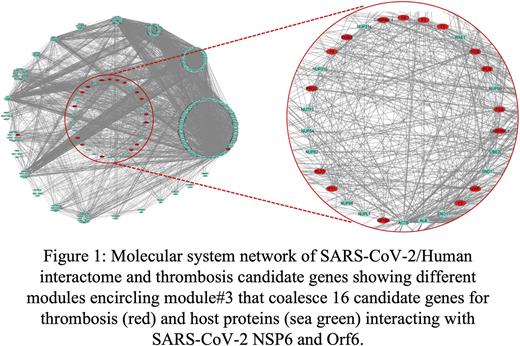Abstract
Background: Pathological advancement of SARS-CoV-2 infection entails engagement of blood related ailment including thrombosis as one of the clinical manifestations. SARS-CoV-2-Human protein-protein and protein-RNA interactomes have been explored to considerable detail.
Objective: The present study is designed to develop and functionally analyze a combined molecular network of SARS-CoV-2-Human and Thrombosis to delineate candidate molecules that could subsequently be used for the prognosis and designing therapeutic interventions.
Methodology: Briefly, two separate system networks were developed, one for over 500 humans proteins that have shown to interact with the viral genome and 26 different proteins encoded by the SARS-CoV-2 genome. The second network is based on the candidate genes tagged for being aberrated genetically and/or in terms of expression in thrombosis. Both networks were later combined as a singular entity after removing the redundant repetition and orphans' nodes and edges were removed by selective enrichment. The network can then be stratified in different modules primarily based on the promiscuity of the nodes. Complete network and each module were then assessed for in betweenness and shortest path length of edges.
Results: The total interactome contain over 572 nodes sharing a total of 6,283 edges, suggesting substantial cross talk between genes and their encoded protein. The complete systems network comprised of total 22 modules with varying level of intermolecular interactions. Nearly half of the edges (n=246) are stationed with different modules. Out of 60 leading candidate genes of Thrombosis, 16 were found congregated in module#3, making little over 50% of total gene population of the module containing 30 edges with total of 172 inter molecular interactions. Interestingly, in module#3 most proteins, that are part of the SARS-CoV-2/human interactome are nuclear transporter in their core molecular functionality and known to physically interact with NSP9 and Orf6 gene of SARS-CoV-2. Exclusive, close network of module#3 partner molecules require addition of one more candidate gene namely, NUP85 that may form the molecular basis of COVID-19 associated thrombosis (Figure 1). Biological functions and KEGG analysis of the holistic network and modular compartment further strengthen the predicted candidate gene status as central to the disease biology.
Conclusion: The candidate genes identified in the study could later be used as markers for prognosis of the pathology of the COVID-19 for thrombosis and/or developing therapeutic intervention. Additionally, this approach may be helpful in differentiating COVID-19 severity and persistent pathogenesis observed in long COVID syndrome.
Disclosures
No relevant conflicts of interest to declare.
Author notes
Asterisk with author names denotes non-ASH members.


